Pore Water Salinity in a Clay Soil Sample
| ✅ Paper Type: Free Essay | ✅ Subject: Engineering |
| ✅ Wordcount: 4415 words | ✅ Published: 20 Dec 2017 |
Literature Review
The aim of this literature review is to assess current research on the impact of salinity of pore water on the engineering properties of the soil, including shear strength and classification of the soil, ideally using Atterburg limits. The review focuses on the study of different soils and the impact of salinity on the engineering properties of the soil, addressing the types of experiments, the procedures in setting up the samples and the tests conducted as this will provide background information for the tests conducted in this dissertation. The literature review also examines the results of these tests as this will be useful for comparison of data during the analysis stage of this dissertation.
Engineering Properties of Soil
According to Ajam et al. (2015, p.350) the engineering characteristics of fine-grained soils, particularly clayey soils are influenced by a range of factors including density, porosity, and structure, as well as the history of tension and granulation, type of clayey minerals and plastic property. The engineering characteristics are also influenced by the type of minerals and the volume of these minerals in the pore water. This suggests that any change in these characteristics will lead to a corresponding change in the physical and mechanical characteristics of the soil. Engineering properties such as density, shear strength and the plasticity of soil are important as these properties affect the structural performance of the soil particularly under foundations and in other civil engineering applications. In basic engineering theory on soil mechanics, it is commonly assumed that the pore water and solid particles are chemically inert, in other words there is no chemical interaction between the different phases. However, Ajam et al. (2015, p.350) point out that the surface of clayey mineral particles is negatively charged which means that electrochemical forces exist between the solid, liquid and dissolved phases which influences the mechanical behaviour of clayey soil. In addition, it is known that the quantity and nature of electro-chemical forces depends on the type of anion and cation in exchange phase and the impact of this interaction on the cation exchange capacity. Ajalloeian et al. (2013, p.1419) make the point that the properties of water used in construction activities such as mixing concrete is governed by regulations and international standards, however there are fewer standards, governing the properties of water used in works associated with soil for example in the construction of earthen dams. Yet there is evidence to suggest that some minerals such as salt can affect the mechanical properties of soil. Bouksila et al. (2008, p. 254) suggest that the impact of the saline on the soil is dependent on the solubility of the soil. Suganya and Sivapullaiah (2015, p.913) argue that the behaviour of the soil is dependent on the microstructure which in turn can be influenced by the water content and the chemical content of that water. Lolaev et al. (1997, p.215) suggests that the temperature of the soil and the chemical content of the salt can influence the bonds between particles within the micro-structure which in turn affects the engineering properties of the soil. Chaney and Demars (1985, p.219) point out that salt in pore can affect soil behaviour particularly in leaching which in a slope can lead to a landslide.
Salinity and Microstructure
The aim of this dissertation is to investigate the change in shear strength in the sample soil by considering the effect of values 0%, 10%, 20%, 30% and 100% of pore water salinity and it is therefore prudent to examine similar studies, to determine the types of tests conducted and the results of those tests as this can then be used in assessing the outcomes of the dissertation research. According to Santamarina (2003, p.25) soils are particulate materials which means that the behaviour of soils is determined by the forces particles experience, including forces due to boundary loads which are transmitted through the skeleton of the soil and particle-level forces such as gravitational and buoyant forces as well as hydrodynamic forces. Soil particles are also influenced by contact level forces such as capillary, electrical and cementation reactive forces. It is the balance between these forces that determine soil behaviour and very often laboratory testing can be used to understand and predict this behaviour. Sassa et al. (2007, p.143) makes the point, for example that the shear strength of mudstone is dependent on the chemistry of the mineral and their reaction with saline. It is clear therefore that there is a link between saline pore water and the engineering performance of soils, however it can be difficult to predict and simulate this behaviour.
Tiwari et al. (2005, p.1445) suggest that an inward diffusion of the salt into clay can lead to an increase in the mean aggregate radius, which changes the structural component of the soil into what can be described as “irregular aggregation”. In soils that have more than 10% clay content the use of a saline pore water fluid can affect the physicochemical structure of the soil, affecting changes strength and compressibility of the material. For example, Kenney (1967, 1977) cited by Tiwari et al. (2005, p.1445) showed that increasing the NaCl concentration in pore fluid could lead to an increase of up to 200% in residual shear strength. Gratchev and Sassa (2013)
One of the difficulties with understanding the impact of salt on soil behaviour is that according to Chaney and Demars (1985, p.219) it is difficult to match the salinity in the field with laboratory testing because of the interstitial nature of pore-water salinity.
Research on Saline Pore Fluid and Soil
According to a study conducted by Nagase et al. (2006, p.209) the concentration of salt (NaCl) in the pore fluid affects the mechanical properties of soil as evidenced by the fact that during a recent earthquake in Japan, the saline concentration of the soil decreased due to leaching and there was a corresponding decrease in the cyclic strength of soil. Messad and Moussai (2016, p.301) studied the impact of saline on sabkha soils which are typically low strength and high compressible materials in which it is difficult to design and construct foundations. In this study the effect of salts on water content and Atterberg limits of the sabkha soil was conducted with tests using distilled water and natural sabkha brine along with saline solutions with different salt concentrations. The results revealed that the liquid and plastic limits decrease with pore fluid salinity when using conventional water content. However, it was also noted that liquid limit and plastic limit increase when the fluid content method is used.
van Paassen and Gareau (2004, p.327) also studied the effect of pore water salinity on shear strength and compressibility of remoulded clay. The study sought to compare the results with marine clay from the Caspian Sea which has a known lower shear strength than anticipated as well as a higher moisture content. This clay also has lower pre-consolidation pressures than the calculated in-situ effective stress which indicated under-consolidation. The results of the study revealed that increasing pore water salinity, led to a decrease in the moisture content of normally consolidated clays and the remoulded shear strength corresponded to these moisture content changes. The compressive behaviour of the clay is explained using the modified effective stress concept which takes account of the pore pressure and effective pressure as well as the electrochemical repulsive and attractive forces between the clay particles. van Paassen and Gareau (2004, p.327) found that the laboratory tests on the remoulded clays revealed the opposite results to those obtained by taking the measurements in the natural soils, which is attributed to the effects of soil structure and preconsolidation pressure. In addition, the results showed that the measured pre-consolidation pressure depends largely on the salinity of the permeating fluid and it was concluded that it is possible to approximate pre-consolidation pressure close to the known geological stress in marine clays with high pore fluid salinity, using a brine solution that closely resembles the pore fluid chemistry.
Yan and Chang (2015, p.153) studied the effects of pore fluid salinity on the shear strength and earth pressure coefficient at rest (K0) of three fine-grained soils including kaolin, bentonite and a marine clay. The K0 coefficient and the critical state friction angle (Ï•’) were determined using triaxial stress path testing on remoulded normally consolidated samples. The Atterberg limit test and sedimentation test revealed that the inter-particle force and soil structure of bentonite were affected by the salinity, whereas the other materials were insensitive to the pore fluid salinity, as shown in Figures 1 to 3. In this study Yan and Chang (2015, p.154) estimated the value of K0 using empirical formulas such as Jaky’s formula and Atterberg limits. It was found that Jaky’s formula satisfactorily predicted K0 for kaolin in all conditions with consistent underestimates for marine clay. In contrast prediction using the Atterberg limits failed in all cases, especially for the particularly for bentonite at low salinity.

Figure 1 Triaxial stress path of testing bentonite with different salt contents (Yan and Chang 2015, p. 156, Figure 4)
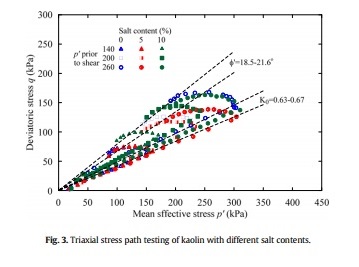
Figure 2 Triaxial stress path of testing of kaolin with different salt contents (Yan and Chang 2015, p. 156, Figure 3)

Figure 3 Triaxial stress path of testing of marine clay with different salt contents (Yan and Chang 2015, p. 156, Figure 5)
The laboratory tests found that the pore fluid salinity has little impact on the value of K0 and Ï•’ in the kaolin samples and the marine clay. However, it was also found that an increase in pore fluid salinity has a corresponding significant increase in Ï•’ for the bentonite and a decrease in the K0. These findings were attributed to the microstructure of the minerals in the materials (Yan and Chang 2015, p.157).
Zhang et al. (2013, p. 69) conducted tests on undrained shear behaviour of loess that was saturated with different concentrations of sodium chloride solution. The aim of the tests was to investigate the effects of NaCl concentration in pore water and desalinisation on the shear behaviour of the samples in undrained conditions. The samples of loess were taken from the ground surface in China and were saturated by de-aired, distilled water with different concentrations of NaCl. Each sample was then subjected to shear in undrained conditions. The samples were then remoulded and re-set into a shear box and re-saturated by passing through de-aired, distilled water and essentially desalinised, and subjected to shear testing, again in undrained conditions. The results of both sets of tests were compared and it was found that variation of NaCl concentration in the pore water affects the shear behaviour of saturated loess, with increases in peak shear strength and steady-state strength corresponding to increases in NaCl concentration until a peak value after which shear decreases with increases in NaCl concentration. It was also noted that the effects were reversible as the peak shear strength and steady-state strength of the desalinised samples recovered to those found in the original sample.
Ajalloeian et al. (2013, p.1422) conducted a study to assess the impact of salt water on the behavioural parameters of fine-grained soil. The tests started by determining the basic characteristics of the soil and water samples, followed by laboratory tests including Atterberg limits, standard compaction and consolidation tests as well as direct shear testing and dispersion tests including the pinhole test and chemical method. The soil sample was graded in compliance with ASTM D 4318 on soil passing no. 100 sieve, consisting of 37% gravel and sand, 35% silt and 28% clay. An XRD analysis of the material revealed that the fine grains of soil consist mainly of quartz, calcite and dolomite with some gypsum and 5% of the clay mineral montmorillonite.
The samples of this fine soil were subjected to three different type of water with varying salt content, namely distilled water, half saline and fully saline water. Atterberg Limits. The tests were performed according to ASTM D 4318 on soil passing no. 100 sieve. For half saline and saline water, this test was performed at 0, 24 and 48 hours after soil and water exposure. The compaction test was used to impact of the type of water on optimum moisture content and maximum dry density. The test was carried out according to ASTM D698-70 on soil passing no. 5 sieve with the saline test carried out at 24 hours and 48 hours after soil and water exposure. consolidation test was performed according to ASTM D2435 on soil passing no. 60 sieve and the process involved compacting a sample at optimum moisture content in a 20mm thick consolidation ring with a 70 mm diameter. The mould was left under loading equipment and a load of 1 kPa was applied on it and the sample was immersed for 24 hours. Then the sample was loaded with the stresses of 0.25, 0.5, 1, 2 and 2.5 kg/cm2. In the direct shear test, performed according to ASTM D3080 on soil passing no. 5 sieve the soil was compacted at optimum water content in 10 x 10mm mould apparatus at stresses of 0.5, 1 and 2 kg/cm2 and shearing velocity was 0.35 mm/min. “Before shearing at each stress, the sample was immersed and consolidated during 24 hours under the same stress” (Ajalloeian et al. 2013, p.1421).
According to Ajalloeian et al. (2013, p.1424), the results showed that plastic limits with distilled, half saline and saline water are 21.31, 20.43 and 20.12 respectively. Salinity has little effect on the plastic limit however this depends on the moisture content of the soil which could affect the interaction between soil and solute in water. But in liquid limit, in which soil moisture is higher, the effect of salinity will be more. The liquid limit has decreased 5 and 17 percent with half saline and saline water respectively. Mahasneh (2004) cited by Ajalloeian et al. (2013, p.1425) attributed the decrease in liquid limit and plastic index by using saline water of Dead Sea to substitution of water molecules by salts that led to the decrease of the double layer thickness and water content and subsequently it stiffened the soil. Ajalloeian et al. (2013, p.1424) also cites Mansour et al, (2008) who indicate that the presence of high valence exchangeable cations in Dead Sea brine decrease the repulsive forces in the soil microstructure thus influencing soil behaviour. This means that the Vander Waals attractive forces are dominant, which increases the capillary stress between particles boundaries. Ultimately this reduces the available surface for interaction with water as shown in the Atterberg limits. In the present study, the lower part of changes of Atterberg limits are attributed to decrease in the double layer thickness and most of the changes can be attributed to sediment salt in the soil pores, because the XRD analysis showed montmorillonit content in the soil was approximately 5%. On the other hand, salt crystals were seen in the soil after drying it. The plastic index also decreased along with the liquid limit because of the increase in salinity of the pore water fluid.
The results showed that the Atterberg limits, compression index and swelling index as well as the coefficient of volume compressibility (mv) and coefficient of compressibility (av) decreased as water salinity increased. In addition, it was clear that the coefficient of consolidation and shear strength parameters increased with increase water salinity. These impacts were attributed to the increasing attractive force between soil particles, which establishes a bond between them, forming salt crystals in pores soil and effectively acting as a cement. Despite the fact that the concentration of saline water is 50 times more than that of half saline water, the difference between soil properties is not noticeable and it appears that the variations on the soil properties decreases as water salinity increases. However, the study also found that excessive concentration of water tends to cause cations to combine with anions to form salts before they can influence the clay minerals. This means that an increase in concentration of water does not have significant impact on the behaviour of the soil. The consolidation tests showed that soil behaviour with all three types of water is similar at high pressure, attributed to the fact that inter-particles bonds are broken at high pressures.
In another study, Otoko (2014, pp.9-10) investigated the impact of saline water from the Atlantic shore on three type of soil including a clay, clayey sand and base course material. Prior to testing 10kg of each of these soil types were dried at 100oC, sieved to establish grading in accordance with ASTM D421 and ASTM D422, as shown in Figure 4 and stored at room temperature.
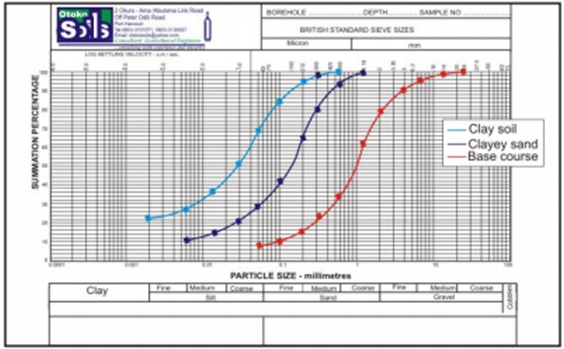
Figure 4 Particle Size Distribution of clay, clayey sand and base course samples (Otoko 2014, p.10, Figure 2)
An analysis of the physical properties of the above soils indicate that the clay sample has the highest specific gravity of 2.75, with the base course sample having the lowest value of 2.50. The moisture content was also measured and ranged from 15% to 29% for the clay soil, 13% to 15% for the clayey sand sample and 11% to 14% for base course (Otoko 2014, p. 14).
A series of six samples were prepared using 3kg of each of the materials; one mixed with tap water and the other with saline water from the Atlantic Ocean salty for each type of soil. Compaction tests were then carried out to establish optimum moisture content and dry unit weight in accordance with ASTM D698 – 78, ASTM and AASHTO T180 – 90, with results shown in Figures 5 to 7.
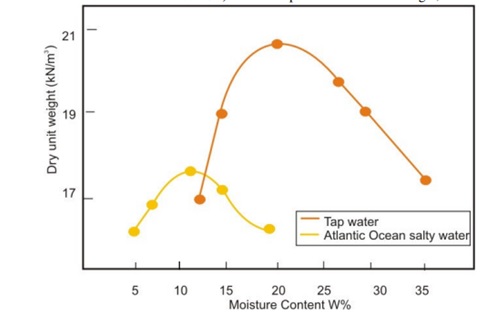
Figure 5 Compaction Curves for Clay soil using tap water and Atlantic Ocean saline water (Otoko 204, p. 11, Figure 3)

Figure 6 Compaction Curves for Clay sand using tap water and Atlantic Ocean saline water (Otoko 204, p. 11, Figure 4)

Figure 7 Compaction Curves for Base course sample using tap water and Atlantic Ocean saline water (Otoko 2014, p. 12, Figure 5)
These figures indicate that the maximum dry unit weights of the clay were 20.9, with the clayey sand and the base course material having dry unit weights of 22.5 and 19.5kN/m3 respectively when mixed with tap water. The maximum dry unit weight for the clay decreased from 20.9kN/m3 to 17.5kN/m3 when the material was mixed with saline water. However, it was noted that there was an increase in the maximum dry unit weight for both clayey sand and base course from 19.5kN/m3 to 20.5kN/m3 and from 22.5kN/m3 to 23.2kN/m3 respectively. This is attributed to changes in the intermolecular structure, where in the clay sample the saline induced repulsive force between the salt molecules and the clay intermolecular structure, which increased the intermolecular distances and void ratios in the sample whereas the increase in the dry unit weight of the base course is attributed to a chemical reaction between the salt molecules and soil particles, thus hardening the material and increasing the dry unit weight (Otoko 2014, p.14).
A further 100g of the materials were mixed with tap water and Atlantic Ocean saline water for the Atterberg’s Limits test. Six paste specimens were prepared to determine the Atterberg limit of the soils. The results of these tests showed that each of the soils tended to stiffen with decreased Atterberg limits for the samples with salt water as shown in Table 1.
Table 1 Effect of Saline water on Atterberg limits and compactions (Otoko 204, p. 13, Table 1)
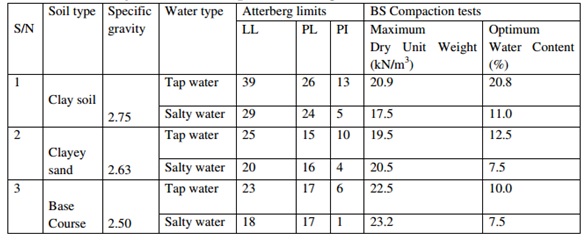
The samples were also subjected to unconfined compression testing that had been compacted to optimum water content and placed in a cylindrical shaped mould measuring 112.5mm height and 50.0mm diameter as specified in ASTMD 2166 – 85. The results of these tests are shown in Figures 8 to 10 (Otoko 2014, p.11).
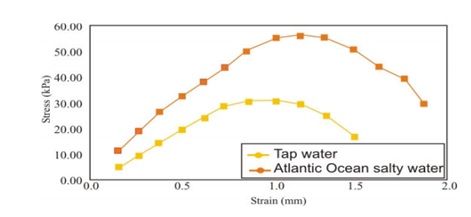
Figure 8 Stress strain relationship for Clay soil with tap water and Atlantic Ocean saline water (Otoko 2014, p.13, Figure 6)

Figure 9 Stress strain relationship for Clay sand sample with tap water and Atlantic Ocean saline water (Otoko 2014, p.13, Figure 7)
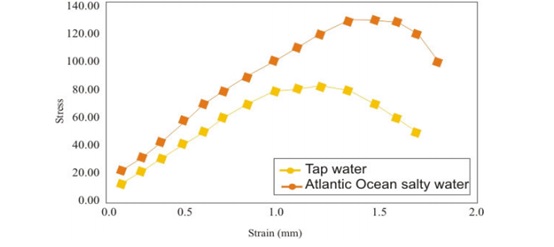
Figure 10 Stress strain relationship for Base course with tap water and Atlantic Ocean saline water (Otoko 2014, p.13, Figure 6)
In the above figures, the relationship between the unconfined shear strength and strain from three soil types using tap and salty water show that the clay soil sample and the clayey sand sample have higher unconfined compressive strength for the saline state. This is attributed to the fact that the clay soil has “multi layers of gibbsite and silica sheets with hydrogen bonding linking these sheets” which become closer under axial compression, which increases resistance to compression and leads to higher shear strength (Otoko 2014, p.14). In contrast, the structure of base course contains compacted calcium oxide molecule, which as shown in Figure 10, fails “more rapidly than clay”, with the saline water enhancing the shear strength of the base course, largely because of the conversion of the calcium oxides and hydroxide into calcium chloride, which can resist higher values of shear (Otoko 2014, p.15).
A study conducted by Gratchev et al. (2007, p.349), into the cyclic behaviour of bentonite-sand mixtures that were treated with salt, found that the “cyclic shear strength at lower concentrations of salt was greater than that obtained at higher salt concentrations”. Gratchev and Sassa (2013, p.1817) studied the cyclic behaviour of soil under different physico-chemical conditions by conducting a series of undrained cyclic stress-controlled ring-shear tests on a natural soil permeated with solutions of NaCl, sodium hydroxide (NaOH), and sulfuric acid (H2SO4) to examine the cyclic behaviour of soil with different pore fluids. The study concluded that an increase in NaCl concentration from 1 meq/L to 11 meq/L leads to a corresponding decrease in the shear resistance of soil to cyclic loading. In addition, it was found that the soil environment affects the behaviour of the soil, for example in acidic and alkaline environments, it was found that the cyclic shear strength of soil decreases compared to specimens with distilled water. The changes in the cyclic behaviour of soil with different pore fluids are attributed to changes in the diffuse double layer of clay, whereby large concentrations of NaCl, NaOH, and H2SO4 can decrease the thickness of the diffuse double layer, thus producing soil structures that are less resistant to cyclic loading (Gratchev & Sassa 2013, p.1820).
Summary of Literature Review
The engineering characteristics of fine-grained soils, particularly clayey soils are influenced by factors such as density and porosity, structure, type of minerals and plastic properties. Any change in these characteristics will ultimately change the physical and mechanical characteristics of the soil. The addition of salt to pore water can affect the behaviour of the soil by influencing the electrochemical forces exist between the solid, liquid and dissolved phases. It is acknowledged that it is possible to conduct laboratory tests to understand the impact of saline pore water fluid on soil behaviour although it is difficult to mirror actual site conditions. A number of different research experiments were investigated, which revealed that:
- the concentration of salt (NaCl) in the pore fluid affects the mechanical properties of soil.
- the impact depends on the type of soil; for example, the impact of saline pore water on low strength, highly compressible soils, such as sabkha, increases the liquid limit and plastic limit.
- increasing pore water salinity in some soils can decrease in the moisture content of normally consolidated clays and the remoulded shear strength, whereas variations of salt content in materials such as loess increases the peak shear strength and steady-state strength.
- in some soils, such as kaolin, the Atterberg limits and compression index, as well as the swelling index and the coefficient of volume compressibility decreased, as water salinity increased.
- shear strength parameters increase with increased water salinity, attributed to the increasing attractive force between soil particles, which establishes a bond between them, forming salt crystals in pores soil and effectively acting as a cement.
- in cyclic behaviour of soil under different physico-chemical conditions an increase in NaCl concentration leads to a corresponding decrease in the shear resistance of soil to cyclic loading.
- the soil environment affects the behaviour of the soil, for example in acidic and alkaline environments, cyclic shear strength of soil decreases compared to specimens with distilled water.
References
Ajam, M., Sabour, M.R. and Dezvareh, G.A., 2015. Study of water salinity effect on geotechnical behavior of soil structure using response surface method (RSM), (Case study: Gotvand Dam). Ciencia & Natura, 37, pp.350-359.
Ajalloeian, R., Mansouri, H. and Sadeghpour, A.H.,2013. Effect of Saline Water on Geotechnical Properties of Fine-grained Soil. Electronic Journal of Geotechnical Engineering, 18, pp.1419-1436.
Bouksila, F., Perrson, M., Berndtsson, R. and Bahrii, A.,2008. Soil water content and salinity determination using different dielectric methods in saline gypsiferous soil. Hydrological Sciences Journal, 53:1, 253-265.
Chaney, R.C. and Demars, K.R., 1985. Strength Testing of Marine Sediments: Laboratory and In-situ Measurements: a Symposium Sponsored by ASTM Committee D-18 on Soil and Rock, San Diego, CA, 26-27 Jan. 1984, Issue 883. New York: ASTM International
Gratchev, I., Sassa, K., Osipov, V., Fukuoka, H., and Wang, G., 2007. Undrained cyclic behavior of bentonite-sand mixtures and factors affecting it.” Geotechnical and Geoenvironmental Engineering. 25(3), pp. 349–367
Gratchev, I.B. and Sassa, K., 2013. Cyclic shear strength of soil with different pore fluids. Journal of Geotechnical and Geoenvironmental Engineering, 139(10), pp.1817-1821.
Lolaev, A.B., Shklyarov, N.D. and Lyalina, O.A., 1997. Effects of salts on physical and mechanical properties of frozen soils. Engineering Geology and the Environment In Marinos, G. (ed.) Engineering Geology and the Environment, Volume 1. Boca Raton: CRC Press, pp.215-220.
Messad, A. and Moussai, B., 2016. Effect of water salinity on Atterberg limits of El-Hodna sabkha soil. Bulletin of Engineering Geology and the Environment, 75(1), pp.301-309.
Nagase, H., Shimizu, K., Hiro-oka, A., Tanoue, Y., and Saitoh, Y.,2006. Earthquake-induced residual deformation of Ariake clay deposits with leaching. Soil Dynamics Earthquake Engineering, 26(2–4), pp. 209–220.
Otoko, G.R., 2014. The Effect of Salt Water on the Physical Properties, Compaction Characteristics and Unconfined Compressive Strength of a Clay, Clayey Sand and Base Course. European International Journal of Science and Technology 3(2), pp.9-17.
Santamarina, J.C., 2003. Soil behavior at the microscale: particle forces. Geotechnical Special Publication, pp.25-56.
Sassa, K., Fukuoka, H., Wang, F. and Wang, G., 2007. Progress in Landslide Science. London: Springer Science.
Suganya, K. and Sivapullaiah, P.V., 2015. Effect of changing water content on the properties of Kuttanad soil. Geotechnical and Geological Engineering,33(4), pp.913-921.
Tiwari, B., Tuladhar, G.R. and Marui, H., 2005. Variation in residual shear strength of the soil with the salinity of pore fluid. Journal of geotechnical and geoenvironmental engineering, 131(12), pp.1445-1456.
van Paassen, L.A. and Gareau, L.F., 2004. Effect of pore fluid salinity on compressibility and shear strength development of clayey soils. In Engineering Geology for Infrastructure Planning in Europe. Berlin Heidelberg: Berlin, pp. 327-340.
Yan, W.M. and Chang, J., 2015. Effect of pore water salinity on the coefficient of earth pressure at rest and friction angle of three selected fine-grained materials. Engineering Geology, 193, pp.153-157.
Zhang, F., Wang, G., Kamai, T., Chen, W., Zhang, D. and Yang, J., 2013. Undrained shear behavior of loess saturated with different concentrations of sodium chloride solution. Engineering Geology, 155, pp.69-79.
Zhu, C.M., Ye, W.M., Chen, Y.G., Chen, B. and Cui, Y.J., 2013. Influence of salt solutions on the swelling pressure and hydraulic conductivity of compacted GMZ01 bentonite. Engineering Geology, 166, pp.74-80.
Cite This Work
To export a reference to this article please select a referencing stye below:
Related Services
View allDMCA / Removal Request
If you are the original writer of this essay and no longer wish to have your work published on UKEssays.com then please click the following link to email our support team:
Request essay removal


